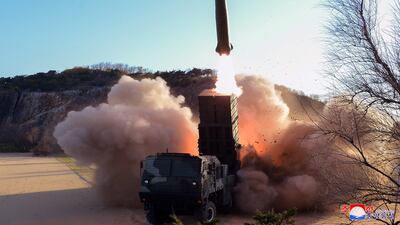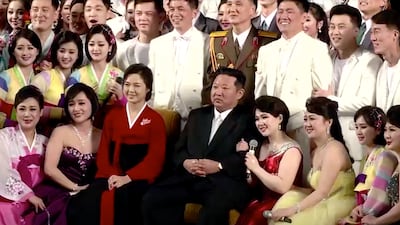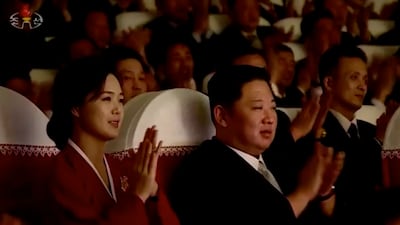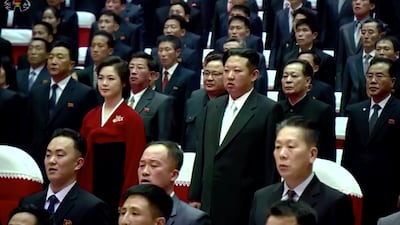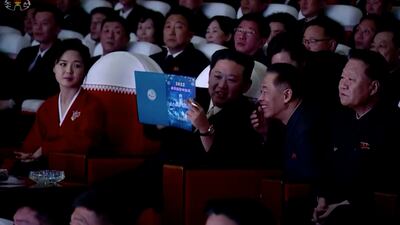North Korea has reportedly test-fired a new tactical guided weapon designed to boost its nuclear fighting capability.
This came days after the country marked its biggest state anniversary without a military parade, which it typically uses to unveil provocative weapons systems.
The test is the 13th round of weapons launches by North Korea this year. There are concerns that Pyongyang may soon conduct a larger provocation such as a nuclear test in an effort to expand its weapons arsenal and increase pressure on its rivals amid stalled diplomacy.
The official Korean Central News Agency said leader Kim Jong-un and other top officials observed the launch.
It said the weapon tested has “great significance in drastically improving the firepower of the frontline long-range artillery units, enhancing the efficiency in the operation of tactical nukes and diversification of their firepower missions”.
KCNA did not elaborate, but the mention of “tactical nukes” suggested the weapon is probably capable of carrying a battlefield nuclear warhead that could hit strategic targets in South Korea, including US military installations. The report did not mention the time and place of the launch.
“North Korea is trying to deploy not only long-range nuclear missiles aimed at American cities but also tactical nuclear weapons to threaten Seoul and US bases in Asia,” said Leif-Eric Easley, a professor at Ewha University in Seoul. “Pyongyang’s purposes likely exceed deterrence and regime survival. Like Russia employs the fear it could use tactical nukes, North Korea may want such weapons for political coercion, battlefield escalation and limiting the willingness of other countries to intervene in a conflict.”
Some observers speculated that the weapon tested might be a smaller, lighter version of North Korea’s nuclear-capable KN-23 missile that has a highly manoeuvrable and lower-trajectory flight aimed at defeating missile defence systems. Others said it could be a new missile that combines the technical characteristics of the KN-23 and another short-range ballistic missile called the KN-24.
South Korea’s Joint Chiefs of Staff said that it had detected two projectile launches from the North’s eastern coastal town of Hamhung on Saturday.
It said the projectiles flew about 110 kilometres at an apogee of 25km and at a maximum speed of Mach 4. It said South Korean and US intelligence authorities are analysing additional details of the launches. South Korea’s presidential office said officials had met twice this weekend to discuss the North Korean military activities.
North Korea started the year with many weapons tests, including its first flight test of an intercontinental ballistic missile since 2017. South Korean and US officials said Pyongyang could soon launch additional provocations such as another ICBM test, a rocket launch to put a spy satellite into orbit or even a nuclear test explosion, which would be the seventh.
South Korea’s military said it had detected signs that North Korea was rebuilding tunnels at a nuclear testing ground it partially dismantled weeks before it entered now-dormant nuclear talks with the United States in 2018.
Sunday’s KCNA dispatch quoted Mr Kim as presenting unspecified tasks to build up North Korea’s nuclear combat forces and its defence capability after praising what he called successive progress in its efforts to reinforce the country’s war deterrence power.
The North’s recent testing activity involved the sophisticated weapons systems Mr Kim has vowed to introduce to cope with what he calls American hostility. Analysts say North Korea may perform more missile tests after the South Korean and US militaries begin their annual drills this week because North Korea views them as an invasion rehearsal.
“North Korea has a domestic imperative to make and perfect weapons ordered by Kim Jong-un last year regardless of what the US does or doesn’t do. The test also tells his people that their country is strong despite their apparent economic difficulties,” said Duyeon Kim, a senior analyst at Washington’s Centre for a New American Security.
“One reason for the political timing could be to protest anticipated US-South Korea military drills.”
On Friday, Mr Kim attended a civilian parade in Pyongyang that marked the 110th birth anniversary of his state-founding grandfather, Kim Il-sung. It appeared the country passed its most important national holiday without a highly anticipated military parade to display its new weapons systems.
North Korea may still hold a military parade on the April 25 founding anniversary of its army. But if that anniversary passes without a military parade again, some experts say that might mean Mr Kim does not have new powerful missiles to show and that his next provocative step will probably be a nuclear test.
Kim Jong-un makes rare appearance with his wife — in pictures
Company%20profile
%3Cp%3E%3Cstrong%3ECompany%20name%3A%3C%2Fstrong%3E%20Letswork%3Cbr%3E%3Cstrong%3EStarted%3A%3C%2Fstrong%3E%202018%3Cbr%3E%3Cstrong%3EBased%3A%3C%2Fstrong%3E%20Dubai%3Cbr%3E%3Cstrong%3EFounders%3A%20%3C%2Fstrong%3EOmar%20Almheiri%2C%20Hamza%20Khan%3Cbr%3E%3Cstrong%3ESector%3A%3C%2Fstrong%3E%20co-working%20spaces%3Cbr%3E%3Cstrong%3EInvestment%20stage%3A%3C%2Fstrong%3E%20%242.1%20million%20in%20a%20seed%20round%20with%20investors%20including%20500%20Global%2C%20The%20Space%2C%20DTEC%20Ventures%20and%20other%20angel%20investors%3Cbr%3E%3Cstrong%3ENumber%20of%20employees%3A%3C%2Fstrong%3E%20about%2020%3C%2Fp%3E%0A
First-round leaderbaord
-5 C Conners (Can)
-3 B Koepka (US), K Bradley (US), V Hovland (Nor), A Wise (US), S Horsfield (Eng), C Davis (Aus);
-2 C Morikawa (US), M Laird (Sco), C Tringale (US)
Selected others: -1 P Casey (Eng), R Fowler (US), T Hatton (Eng)
Level B DeChambeau (US), J Rose (Eng)
1 L Westwood (Eng), J Spieth (US)
3 R McIlroy (NI)
4 D Johnson (US)
The Sand Castle
Director: Matty Brown
Stars: Nadine Labaki, Ziad Bakri, Zain Al Rafeea, Riman Al Rafeea
Rating: 2.5/5
More from Armen Sarkissian
Set-jetting on the Emerald Isle
Other shows filmed in Ireland include: Vikings (County Wicklow), The Fall (Belfast), Line of Duty (Belfast), Penny Dreadful (Dublin), Ripper Street (Dublin), Krypton (Belfast)
Teri%20Baaton%20Mein%20Aisa%20Uljha%20Jiya
%3Cp%3E%3Cstrong%3EDirectors%3A%3C%2Fstrong%3E%20Amit%20Joshi%20and%20Aradhana%20Sah%3C%2Fp%3E%0A%3Cp%3E%3Cstrong%3ECast%3A%3C%2Fstrong%3E%20Shahid%20Kapoor%2C%20Kriti%20Sanon%2C%20Dharmendra%2C%20Dimple%20Kapadia%2C%20Rakesh%20Bedi%3C%2Fp%3E%0A%3Cp%3E%3Cstrong%3ERating%3A%3C%2Fstrong%3E%204%2F5%3C%2Fp%3E%0A
The biog
First Job: Abu Dhabi Department of Petroleum in 1974
Current role: Chairperson of Al Maskari Holding since 2008
Career high: Regularly cited on Forbes list of 100 most powerful Arab Businesswomen
Achievement: Helped establish Al Maskari Medical Centre in 1969 in Abu Dhabi’s Western Region
Future plan: Will now concentrate on her charitable work
A list of the animal rescue organisations in the UAE
Racecard
6pm: Al Maktoum Challenge Round 2 Group 1 (PA) $55,000 (Dirt) 1,900m
6.35pm: Oud Metha Stakes Rated Conditions (TB) $60,000 (D) 1,200m
7.10pm: Jumeirah Classic Listed (TB) $150,000 (Turf) 1,600m
7.45pm: Firebreak Stakes Group 3 (TB) $150,000 (D) 1,600m
8.20pm: Al Maktoum Challenge Round 2 Group 2 (TB) $350,000 (D) 1,900m
8.55pm: Al Bastakiya Trial Conditions (TB) $60,000 (D) 1,900m
9.30pm: Balanchine Group 2 (TB) $180,000 (T) 1,800m
Suggested picnic spots
Abu Dhabi
Umm Al Emarat Park
Yas Gateway Park
Delma Park
Al Bateen beach
Saadiyaat beach
The Corniche
Zayed Sports City
Dubai
Kite Beach
Zabeel Park
Al Nahda Pond Park
Mushrif Park
Safa Park
Al Mamzar Beach Park
Al Qudrah Lakes
More on Palestine-Israeli relations
The 12 Syrian entities delisted by UK
Ministry of Interior
Ministry of Defence
General Intelligence Directorate
Air Force Intelligence Agency
Political Security Directorate
Syrian National Security Bureau
Military Intelligence Directorate
Army Supply Bureau
General Organisation of Radio and TV
Al Watan newspaper
Cham Press TV
Sama TV
F1 The Movie
Starring: Brad Pitt, Damson Idris, Kerry Condon, Javier Bardem
Director: Joseph Kosinski
Rating: 4/5
Tell Me Who I Am
Director: Ed Perkins
Stars: Alex and Marcus Lewis
Four stars
Milestones on the road to union
1970
October 26: Bahrain withdraws from a proposal to create a federation of nine with the seven Trucial States and Qatar.
December: Ahmed Al Suwaidi visits New York to discuss potential UN membership.
1971
March 1: Alex Douglas Hume, Conservative foreign secretary confirms that Britain will leave the Gulf and “strongly supports” the creation of a Union of Arab Emirates.
July 12: Historic meeting at which Sheikh Zayed and Sheikh Rashid make a binding agreement to create what will become the UAE.
July 18: It is announced that the UAE will be formed from six emirates, with a proposed constitution signed. RAK is not yet part of the agreement.
August 6: The fifth anniversary of Sheikh Zayed becoming Ruler of Abu Dhabi, with official celebrations deferred until later in the year.
August 15: Bahrain becomes independent.
September 3: Qatar becomes independent.
November 23-25: Meeting with Sheikh Zayed and Sheikh Rashid and senior British officials to fix December 2 as date of creation of the UAE.
November 29: At 5.30pm Iranian forces seize the Greater and Lesser Tunbs by force.
November 30: Despite a power sharing agreement, Tehran takes full control of Abu Musa.
November 31: UK officials visit all six participating Emirates to formally end the Trucial States treaties
December 2: 11am, Dubai. New Supreme Council formally elects Sheikh Zayed as President. Treaty of Friendship signed with the UK. 11.30am. Flag raising ceremony at Union House and Al Manhal Palace in Abu Dhabi witnessed by Sheikh Khalifa, then Crown Prince of Abu Dhabi.
December 6: Arab League formally admits the UAE. The first British Ambassador presents his credentials to Sheikh Zayed.
December 9: UAE joins the United Nations.
Read more from Aya Iskandarani
Keep it fun and engaging
Stuart Ritchie, director of wealth advice at AES International, says children cannot learn something overnight, so it helps to have a fun routine that keeps them engaged and interested.
“I explain to my daughter that the money I draw from an ATM or the money on my bank card doesn’t just magically appear – it’s money I have earned from my job. I show her how this works by giving her little chores around the house so she can earn pocket money,” says Mr Ritchie.
His daughter is allowed to spend half of her pocket money, while the other half goes into a bank account. When this money hits a certain milestone, Mr Ritchie rewards his daughter with a small lump sum.
He also recommends books that teach the importance of money management for children, such as The Squirrel Manifesto by Ric Edelman and Jean Edelman.
How much of your income do you need to save?
The more you save, the sooner you can retire. Tuan Phan, a board member of SimplyFI.com, says if you save just 5 per cent of your salary, you can expect to work for another 66 years before you are able to retire without too large a drop in income.
In other words, you will not save enough to retire comfortably. If you save 15 per cent, you can forward to another 43 working years. Up that to 40 per cent of your income, and your remaining working life drops to just 22 years. (see table)
Obviously, this is only a rough guide. How much you save will depend on variables, not least your salary and how much you already have in your pension pot. But it shows what you need to do to achieve financial independence.
The%20specs%3A%202024%20Mercedes%20E200
%3Cp%3E%3Cstrong%3EEngine%3A%20%3C%2Fstrong%3E2.0-litre%20four-cyl%20turbo%20%2B%20mild%20hybrid%0D%3Cbr%3E%3Cstrong%3EPower%3A%20%3C%2Fstrong%3E204hp%20at%205%2C800rpm%20%2B23hp%20hybrid%20boost%0D%3Cbr%3E%3Cstrong%3ETorque%3A%20%3C%2Fstrong%3E320Nm%20at%201%2C800rpm%20%2B205Nm%20hybrid%20boost%0D%3Cbr%3E%3Cstrong%3ETransmission%3A%20%3C%2Fstrong%3E9-speed%20auto%0D%3Cbr%3E%3Cstrong%3EFuel%20consumption%3A%20%3C%2Fstrong%3E7.3L%2F100km%0D%3Cbr%3E%3Cstrong%3EOn%20sale%3A%20%3C%2Fstrong%3ENovember%2FDecember%0D%3Cbr%3E%3Cstrong%3EPrice%3A%20%3C%2Fstrong%3EFrom%20Dh205%2C000%20(estimate)%3C%2Fp%3E%0A
A%20MAN%20FROM%20MOTIHARI
%3Cp%3E%3Cstrong%3EAuthor%3A%20%3C%2Fstrong%3EAbdullah%20Khan%0D%3Cbr%3E%3Cstrong%3EPublisher%3A%20%3C%2Fstrong%3EPenguin%20Random%20House%3Cbr%3E%3Cstrong%3EPages%3A%20%3C%2Fstrong%3E304%0D%3Cbr%3E%3Cstrong%3EAvailable%3A%20%3C%2Fstrong%3ENow%0D%3Cbr%3E%3C%2Fp%3E%0A
UAE currency: the story behind the money in your pockets
All or Nothing
Amazon Prime
Four stars
Match info
Liverpool 3
Hoedt (10' og), Matip (21'), Salah (45 3')
Southampton 0
'Operation Mincemeat'
Director: John Madden
Cast: Colin Firth, Matthew Macfayden, Kelly Macdonald and Penelope Wilton
Rating: 4/5
How does ToTok work?
The calling app is available to download on Google Play and Apple App Store
To successfully install ToTok, users are asked to enter their phone number and then create a nickname.
The app then gives users the option add their existing phone contacts, allowing them to immediately contact people also using the application by video or voice call or via message.
Users can also invite other contacts to download ToTok to allow them to make contact through the app.
FIGHT%20CARD
%3Cp%3EAnthony%20Joshua%20v%20Otto%20Wallin%2C%2012%20rounds%2C%20heavyweight%3C%2Fp%3E%0A%3Cp%3EDeontay%20Wilder%20v%20Joseph%20Parker%2C%2012%20rounds%2C%20heavyweight%3C%2Fp%3E%0A%3Cp%3EDmitry%20Bivol%20v%20Lyndon%20Arthur%2C%2012%20rounds%2C%20light%20heavyweight%3C%2Fp%3E%0A%3Cp%3EDaniel%20Dubois%20v%20Jarrell%20Miller%2C%2012%20rounds%2C%20heavyweight%3C%2Fp%3E%0A%3Cp%3EFilip%20Hrgovic%20v%20Mark%20de%20Mori%2C%2012%20rounds%2C%20heavyweight%C2%A0%3C%2Fp%3E%0A%3Cp%3EArslanbek%20Makhmudov%20v%20Agit%20Kabayel%2C%2012%20rounds%2C%20heavyweight%C2%A0%3C%2Fp%3E%0A%3Cp%3EFrank%20Sanchez%20v%20Junior%20Fa%2C%2012%20rounds%2C%20heavyweight%C2%A0%3C%2Fp%3E%0A%3Cp%3EJai%20Opetaia%20v%20Ellis%20Zorro%2C%2012%20rounds%2C%20cruiserweight%3C%2Fp%3E%0A
Director: Laxman Utekar
Cast: Vicky Kaushal, Akshaye Khanna, Diana Penty, Vineet Kumar Singh, Rashmika Mandanna
Rating: 1/5
HAJJAN
%3Cp%3EDirector%3A%20Abu%20Bakr%20Shawky%C2%A0%3C%2Fp%3E%0A%3Cp%3E%3Cbr%3EStarring%3A%20Omar%20Alatawi%2C%20Tulin%20Essam%2C%20Ibrahim%20Al-Hasawi%C2%A0%3C%2Fp%3E%0A%3Cp%3E%3Cbr%3ERating%3A%204%2F5%3C%2Fp%3E%0A
The Pope's itinerary
Sunday, February 3, 2019 - Rome to Abu Dhabi
1pm: departure by plane from Rome / Fiumicino to Abu Dhabi
10pm: arrival at Abu Dhabi Presidential Airport
Monday, February 4
12pm: welcome ceremony at the main entrance of the Presidential Palace
12.20pm: visit Abu Dhabi Crown Prince at Presidential Palace
5pm: private meeting with Muslim Council of Elders at Sheikh Zayed Grand Mosque
6.10pm: Inter-religious in the Founder's Memorial
Tuesday, February 5 - Abu Dhabi to Rome
9.15am: private visit to undisclosed cathedral
10.30am: public mass at Zayed Sports City – with a homily by Pope Francis
12.40pm: farewell at Abu Dhabi Presidential Airport
1pm: departure by plane to Rome
5pm: arrival at the Rome / Ciampino International Airport
Killing of Qassem Suleimani
Porsche Taycan Turbo specs
Engine: Two permanent-magnet synchronous AC motors
Transmission: two-speed
Power: 671hp
Torque: 1050Nm
Range: 450km
Price: Dh601,800
On sale: now
Sustainable Development Goals
1. End poverty in all its forms everywhere
2. End hunger, achieve food security and improved nutrition and promote sustainable agriculture
3. Ensure healthy lives and promote well-being for all at all ages
4. Ensure inclusive and equitable quality education and promote lifelong learning opportunities for all
5. Achieve gender equality and empower all women and girls
6. Ensure availability and sustainable management of water and sanitation for all
7. Ensure access to affordable, reliable, sustainable and modern energy for all
8. Promote sustained, inclusive and sustainable economic growth, full and productive employment and decent work for all
9. Build resilient infrastructure, promote inclusive and sustainable industrialisation and foster innovation
10. Reduce inequality within and among countries
11. Make cities and human settlements inclusive, safe, resilient and sustainable
12. Ensure sustainable consumption and production patterns
13. Take urgent action to combat climate change and its effects
14. Conserve and sustainably use the oceans, seas and marine resources for sustainable development
15. Protect, restore and promote sustainable use of terrestrial ecosystems, sustainably manage forests, combat desertification, and halt and reverse land degradation and halt biodiversity loss
16. Promote peaceful and inclusive societies for sustainable development, provide access to justice for all and build effective, accountable and inclusive institutions at all levels
17. Strengthen the means of implementation and revitalise the global partnership for sustainable development
The biog
Favourite colour: Brown
Favourite Movie: Resident Evil
Hobbies: Painting, Cooking, Imitating Voices
Favourite food: Pizza
Trivia: Was the voice of three characters in the Emirati animation, Shaabiyat Al Cartoon
Specs
Engine: Dual-motor all-wheel-drive electric
Range: Up to 610km
Power: 905hp
Torque: 985Nm
Price: From Dh439,000
Available: Now
Netherlands v UAE, Twenty20 International series
Saturday, August 3 - First T20i, Amstelveen
Monday, August 5 – Second T20i, Amstelveen
Tuesday, August 6 – Third T20i, Voorburg
Thursday, August 8 – Fourth T20i, Vooryburg
MATCH INFO:
Second Test
Pakistan v Australia, Tuesday-Saturday, 10am daily at Zayed Cricket Stadium, Abu Dhabi
Entrance is free
The National Archives, Abu Dhabi
Founded over 50 years ago, the National Archives collects valuable historical material relating to the UAE, and is the oldest and richest archive relating to the Arabian Gulf.
Much of the material can be viewed on line at the Arabian Gulf Digital Archive - https://www.agda.ae/en
Martin Sabbagh profile
Job: CEO JCDecaux Middle East
In the role: Since January 2015
Lives: In the UAE
Background: M&A, investment banking
Studied: Corporate finance
6 UNDERGROUND
Director: Michael Bay
Stars: Ryan Reynolds, Adria Arjona, Dave Franco
2.5 / 5 stars
UAE currency: the story behind the money in your pockets
Who's who in Yemen conflict
Houthis: Iran-backed rebels who occupy Sanaa and run unrecognised government
Yemeni government: Exiled government in Aden led by eight-member Presidential Leadership Council
Southern Transitional Council: Faction in Yemeni government that seeks autonomy for the south
Habrish 'rebels': Tribal-backed forces feuding with STC over control of oil in government territory
